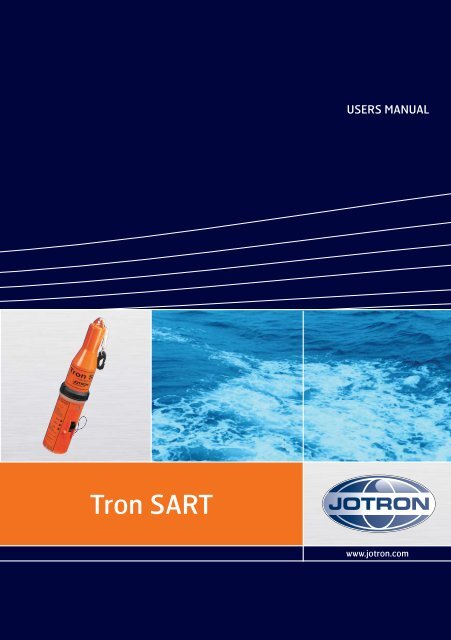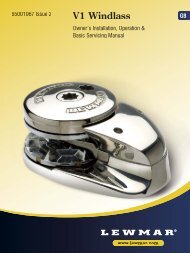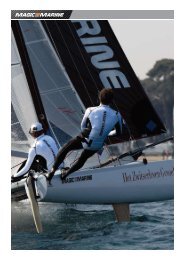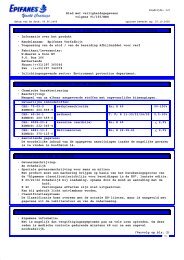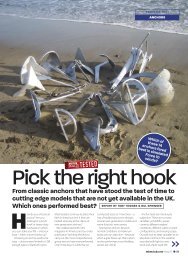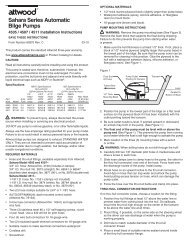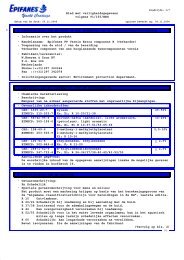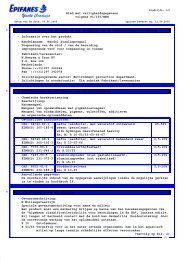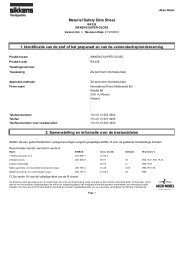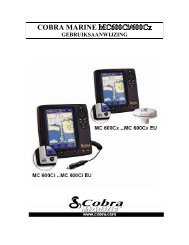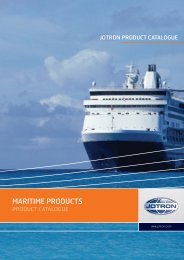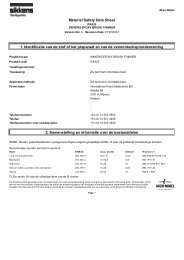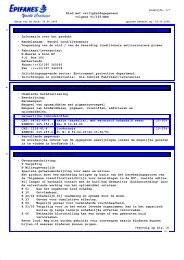Tron SART Radar Transponder User Manual - Marinestore
Tron SART Radar Transponder User Manual - Marinestore
Tron SART Radar Transponder User Manual - Marinestore
You also want an ePaper? Increase the reach of your titles
YUMPU automatically turns print PDFs into web optimized ePapers that Google loves.
USERS MANUAL<br />
<strong>Tron</strong> <strong>SART</strong><br />
www.jotron.com
EC Declaration of Conformity, available at www.jotron.com<br />
Abbreviations and definitions<br />
C O S PA S<br />
COsmicheskaya Sistyema Poiska Avariynich Sudov<br />
(Space System for the Search of Vessels in Distress)<br />
EPIRB<br />
Emergency Position Indicating Radio Beacon<br />
GPS<br />
Global Position System<br />
km<br />
kilometer<br />
LUT<br />
Local <strong>User</strong> Terminal (Ground Station)<br />
MCC<br />
Mission Control Center<br />
MHz<br />
Mega-Hertz (10 6 Hertz)<br />
nm<br />
Nautical mile<br />
PROCESSOR<br />
The processor circuit card in the console that controls system operations and<br />
computes the positioning/navigation solutions.<br />
RCC<br />
Rescue Coordination Center<br />
S A R S A T<br />
Search and Rescue Satellite-Aided Tracking System<br />
2<br />
92478_UM_<strong>SART</strong>_D
SOFTWARE<br />
Values programmed and preloaded into memory. The values represent a<br />
permanent set of instructions for running the automatic functions (computations)<br />
of the unit.<br />
VCO<br />
Voltage Controlled Oscillator<br />
VHF<br />
Very High Frequency -A set of frequencies in the MHz region<br />
VSWR<br />
Voltage standing wave ratio<br />
92478_UM_<strong>SART</strong>_D 3
Amendment Record<br />
AMENDMENT<br />
NO.<br />
INCORP.<br />
BY<br />
DATE PAGE(S) VERSION REASON FOR<br />
CHANGE<br />
1 A EM3829<br />
2 Chapt. 5 B EM 3903<br />
3 C<br />
4 ES 14.03.07 Total 24 D New version<br />
5<br />
6<br />
7<br />
8<br />
9<br />
10<br />
11<br />
12<br />
13<br />
14<br />
15<br />
16<br />
17<br />
4<br />
92478_UM_<strong>SART</strong>_D
The information in this book has been carefully checked and is believed to<br />
be accurate. However, no responsibility is assumed for inaccuracies.<br />
CAUTION!<br />
This equipment contains CMOS integrated circuits. Observe handling<br />
precautions to avoid static discharges which may damage these devices.<br />
Jotron AS reserves the right to make changes without further notice to any<br />
products or modules described herein to improve reliability, function or<br />
design. Jotron AS does not assume any liability arising out of the application<br />
or use of the described product.<br />
Jotron AS. is a prime manufacturer of safety equipment designed for rescue of human lives and<br />
their property. For safety equipment to be effective in line with the design parameters it is<br />
important that they are handled, stowed and maintained in compliance with the manufacturers<br />
instructions. Jotron AS. can not be held responsible for any damage caused due to incorrect use of<br />
the equipment or breach of laid down procedures or for failure of any specific component or other<br />
parts of the equipment.<br />
The chapter covering battery replacement (6.2.1) is added for information only. Jotron AS. does<br />
not take any responsibility for improper disassembling/assembling of the beacon. We strongly<br />
recommend all service to be done by authorized Jotron agents. In addition to normal service, Jotron<br />
agents have the necessary equipment and education to test the operational functions of the beacon.<br />
Non-original maintenance and/or service parts may destroy the equipment function and<br />
performance.<br />
92478_UM_<strong>SART</strong>_D 5
TABLE OF CONTENTS<br />
1 GENERAL DESCRIPTION................................................................................................10<br />
1.1 TRON <strong>SART</strong> FEATURES..................................................................................................................................... 11<br />
2 TECHNICAL SPECIFICATIONS.........................................................................................12<br />
2.1 ELECTRICAL SPECIFICATIONS ........................................................................................................................ 12<br />
2.2 MECHANICAL SPECIFICATION........................................................................................................................ 13<br />
3 FUNCTIONAL DESCRIPTION...........................................................................................14<br />
3.1 GENERAL ................................................................................................................................................ 14<br />
3.1.1<br />
3.1.2<br />
Upper module with transponder and antenna...................................................................14<br />
Battery module.................................................................................................14<br />
3.1.3 O-ring and screw ring..........................................................................................14<br />
4 INSTALLATION ...........................................................................................................15<br />
4.1 BRACKETS............................................................................................................................................... 15<br />
4.1.1 Storage bracket ................................................................................................15<br />
4.1.2 Outdoor lifeboat bracket .......................................................................................16<br />
4.1.3 Fixed lifeboat bracket..........................................................................................16<br />
4.2 USING THE 1M ROPE ......................................................................................................17<br />
4.3 USING THE 1M POLE ......................................................................................................17<br />
5 OPERATION INSTRUCTIONS...........................................................................................18<br />
5.1 ACTIVATING THE TRON <strong>SART</strong>........................................................................................................... 18<br />
5.2 DEACTIVATING THE TRON <strong>SART</strong> ...................................................................................................... 18<br />
5.3 TEST OF THE TRON <strong>SART</strong> .................................................................................................................. 18<br />
6 MAINTENANCE AND TROUBLESHOOTING..........................................................................21<br />
6.1 MAINTENANCE.......................................................................................................................................... 21<br />
6.2 S E R V I C E ...................................................................................................................................... 21<br />
6.2.1<br />
6.2.2<br />
REPLACING THE BATTERY MODULE ....................................................................21<br />
BATTERY DISPOSAL........................................................................................22<br />
6.2.3 INCINERATION ..............................................................................................22<br />
6.2.4<br />
6.2.5<br />
LAND FILLING...............................................................................................22<br />
RECYCLING..................................................................................................22<br />
7 SERVICE AGENTS ........................................................................................................23<br />
6<br />
92478_UM_<strong>SART</strong>_D
BATTERY SAFETY DATA SHEET<br />
(Form: EEC directive 91/155)<br />
(2) SAFETY ADVICE<br />
S2 Keep out of reach of children.<br />
S8 Keep container dry.<br />
S26 In case of contact with eyes, rinse immediately with plenty of water and seek medical advice.<br />
S43 In case of fire, use D type extinguishers. Never use water.<br />
S45 In case of accident or if you feel unwell, seek medical advice immediately (show the label<br />
where possible).<br />
(3) FIRST AID MEASURES<br />
In case of contact of cell contents with eyes, flush immediately with water for 15 min. With skin, wash<br />
with plenty of water and take off contaminated clothes. If inhaled, remove from exposure, give oxygen,<br />
and seek medical advice.<br />
(4) FIRE-FIGHTING MEASURES<br />
Extinguishing media<br />
Suitable: Type D fire extinguishers<br />
Not to be used: Water - CO2 - Halon, dry chemical or foam extinguishers<br />
Special exposure hazards<br />
Generation of chlorine, sulphur dioxide, disulphur dichloride during<br />
thermal decomposition.<br />
Special protective equipment<br />
Use protective working boots, rubber apron and safety glasses with side shields.<br />
92478_UM_<strong>SART</strong>_D 7
INSTRUCTIONS FOR KEEPING THE RADIO LOG AND THE RADIO OPERATORS<br />
OBLIGATION ACCORDING TO NATIONAL AND INTERNATIONAL REGULATION.<br />
1. The radio log shall be kept in accordance with requirements in the Radio Regulations, SOLAS<br />
Convention, national regulations regarding radio installations and the STCW Convention (STCW 95<br />
including the STCW Code) including the relevant regulation regarding watch keeping on board<br />
passenger and cargo ships.<br />
2. Unauthorized transmissions and incidents of harmful interference should, if possible, be identified,<br />
recorded in the radio log and brought to the attention of the Administration in compliance with the Radio<br />
Regulations, together with an appropriate extract from the radio log. (STCW Code B-VIII/2 No.32)<br />
TEST OF RADIO EQUIPMENT AND RESERVE SOURCE OF ENERGY<br />
Weekly:<br />
GMDSS handheld VHF transceivers to be tested without using the mandatory required emergency<br />
batteries.<br />
Monthly:<br />
Float-free and manual EPIRBs to be checked using the means provided for testing on the equipment.<br />
Check data for periodical maintenance requirement for float-free EPIRB search and rescue radar<br />
transponders (<strong>SART</strong>) to be checked against 9 GHz radar.<br />
False alerts transmitted by EPIRB<br />
False alerts are a serious problem for the rescue service. Nearly 90% of EPIRB initiated distress alerts<br />
turn out to be false alarms.<br />
If for any reason, your EPIRB should cause a false alarm, it is most important that you contact the nearest search and<br />
rescue authority and tell them it was a false alarm. They can then stand down any rescue service (coast radio station or<br />
appropriate CES or RCC). Use any means at your disposal to make contact. Switch off the distress alarm by deactivating<br />
your EPIRB, as soon as possible.<br />
8<br />
92478_UM_<strong>SART</strong>_D
TEST AND MAINTENANCE RECORD<br />
DATE N/T/B SIGN INSP<br />
N=NEW EPIRB INSTALLED, T=TEST, B=NEW BATTERY<br />
92478_UM_<strong>SART</strong>_D 9
1 GENERAL DESCRIPTION<br />
<strong>Tron</strong> <strong>SART</strong> is emergency equipment consisting of:<br />
1.<strong>Tron</strong> <strong>SART</strong> radar transponder.<br />
2. Mounting brackets for storage and use.<br />
3. Mounting rope for life rafts / life boats.<br />
The JOTRON 9 GHz radar transponder type <strong>Tron</strong> <strong>SART</strong> is developed to meet the regulations and rules<br />
for use on vessels and life rafts in the maritime service.<br />
<strong>Tron</strong> <strong>SART</strong> meets the specifications for 9 GHz radar transponders for use in search and rescue operations<br />
at sea.<br />
The operating range of the <strong>Tron</strong> <strong>SART</strong> is up to 30 nautical miles, depending on the height of the electronic<br />
unit and the radar height of the search and rescue unit (sea or airborne).<br />
With a radar height of 20m and the <strong>Tron</strong> <strong>SART</strong> placed at 1m above sea level, the range will be up to 10<br />
nautical miles.<br />
<strong>Tron</strong> <strong>SART</strong> is buoyant, however to obtain maximum performance the transponder should be placed in a<br />
vertical position and as high up as possible in order to achieve maximum coverage.<br />
Several mounting brackets and mounting aids are developed to ease a correct mounting and use of the<br />
radar transponder.<br />
The purpose of the <strong>Tron</strong> <strong>SART</strong> is to perform a secondary alarm when search and rescue units are searching<br />
for a life raft / lifeboat in distress. The <strong>Tron</strong> <strong>SART</strong> will help the units to pinpoint exactly where the<br />
distressed boat is located in a larger area. This is done with the help of the radar on the searching ship or<br />
helicopter.<br />
When the <strong>Tron</strong> <strong>SART</strong> is interrogated (hit) by a radar signal, it will immediately start to transmit a number<br />
of sweeps covering the complete maritime 3 cm radar band.<br />
These sweeps are detected on the radar screen and are used to navigate directly towards the distressed life<br />
raft, for details on radar display see chapter 3.3.<br />
Maximum distance to a ship will normally be about 10 nm and approximately 30nm to a helicopter,<br />
dependent on the helicopters altitude. The transponder will not give any alarms further away than this.<br />
The primary alarm will usually be an Emergency Position Indicating Radio Beacon (EPIRB) or distress<br />
call on VHF / HF - manual or via digital selcall.<br />
The <strong>Tron</strong> <strong>SART</strong> should be activated immediately after the EPIRB has been started or by instructions from<br />
the rescue control centre.<br />
The batteries of the <strong>Tron</strong> <strong>SART</strong> will last at least 96 hours in standby after activation and then minimum<br />
8 hours of continuous operation.<br />
10<br />
92478_UM_<strong>SART</strong>_D
Although the transponder does not send any alarm via satellite, VHF or other radio communication, the use<br />
should be limited to short tests and emergency situations.<br />
This is to save battery capacity in case a situation where the transponder is needed.<br />
1.1 <strong>Tron</strong> <strong>SART</strong> features<br />
Watertight:<br />
<strong>Tron</strong> <strong>SART</strong> is watertight to a depth of minimum 1 meter.<br />
Buoyant:<br />
<strong>Tron</strong> <strong>SART</strong> is buoyant in case the transponder is accidentally dropped into the water. To increase coverage<br />
the <strong>Tron</strong> <strong>SART</strong> should always be held or mounted as high as possible.<br />
Rugged design:<br />
The <strong>Tron</strong> <strong>SART</strong> will withstand a drop from 30 meters into the water. It is resistant to seawater, oil and<br />
sunlight.<br />
Handling:<br />
The <strong>Tron</strong> <strong>SART</strong> is made for easy operation, with a brief operating instruction printed on the unit. It<br />
comes standard with a 1 meter rope and a shackle hook to be used for hanging the <strong>Tron</strong> <strong>SART</strong> on the<br />
inside of a life raft.<br />
Indicators:<br />
The <strong>Tron</strong> <strong>SART</strong> is equipped with a LED and a built in speaker to show operation of the <strong>SART</strong>.<br />
The LED will normally flash with a frequency of 1 per second to show that the <strong>SART</strong> is activated.<br />
When a search and rescue unit is approaching the internal speaker will sound each time the <strong>SART</strong> is hit by<br />
the radar. A continuous sound in the loudspeaker means that the ship or helicopter is close to the <strong>SART</strong><br />
and the radar is hitting the <strong>SART</strong> continuously.<br />
Battery unit.<br />
The battery unit consists of the complete lower half of the <strong>Tron</strong> <strong>SART</strong> and is to be replaced every 5. year.<br />
The marking on the battery unit show the expire date.<br />
A new battery comes complete with switch and indicators and is easily replaced by opening the screw ring<br />
between the top and bottom of the <strong>SART</strong>.<br />
92478_UM_<strong>SART</strong>_D 11
2 TECHNICAL SPECIFICATIONS<br />
2.1 ELECTRICAL SPECIFICATIONS<br />
Frequency:<br />
Temperature range:<br />
X-band (3 cm) (9.2 - 9.5 GHz)<br />
Operating: -20 to +55°C<br />
Storage: -30 to +65°C<br />
Radiated power: > 400 mW e.i.r.p (+26 dBm)<br />
Sweep type:<br />
Receive sensitivity:<br />
12 sweep sawtooth type<br />
Forward 7.5 us ±1 ms<br />
Return 0.4 us ±0.1 ms<br />
Starts with return sweep.<br />
Better than -50 dBm e.r.s.<br />
Response delay: Max 0.5 ms<br />
Antenna pattern: Horizontal polarization.<br />
Omni directional radiation in the horizontal plane.<br />
Greater than ±12.5 degrees elevation angle in the<br />
vertical plane.<br />
Battery:<br />
Battery capacity:<br />
Lithium, 5 years service life<br />
96 hours standby +8 hours continuous operating<br />
when activated by a radar with 1 kHz prf at -20°C.<br />
5 years storage.<br />
12<br />
92478_UM_<strong>SART</strong>_D
2.2 MECHANICAL SPECIFICATION<br />
Materials used:<br />
<strong>Transponder</strong> housing:<br />
Bracket:<br />
Polycarbonate with 10% glass.<br />
Anodized aluminum.<br />
<strong>Transponder</strong> dimensions:<br />
Max diameter:<br />
85 mm<br />
Length: 370 mm<br />
Weight:<br />
1050 g<br />
<strong>Transponder</strong> with standard storage bracket:<br />
Max diameter:<br />
Length:<br />
96 mm<br />
376 mm<br />
92478_UM_<strong>SART</strong>_D 13
3 FUNCTIONAL DESCRIPTION<br />
3.1 GENERAL<br />
The <strong>Tron</strong> <strong>SART</strong> consists of upper and lower house mounted together with an O- ring and screw ring.<br />
<strong>Tron</strong> <strong>SART</strong> may be split into the following main parts:<br />
1. Upper module with transponder and antenna<br />
2. Battery module with batteries, main switch, LED indicator and buzzer.<br />
3. O- ring and screw ring.<br />
Battery module<br />
X-96978<br />
O-ring<br />
X-90624<br />
Upper module<br />
X-96974<br />
Screw ring<br />
X-90641<br />
Figure 3.1, <strong>Tron</strong> <strong>SART</strong> disconnected<br />
3.1.1 Upper module with transponder and antenna<br />
The Upper module consists of one printed circuit boards, a VCO and antenna, which are mounted in the<br />
upper housing:<br />
1. The main board.<br />
2. VCO.<br />
3. Antenna (9GHz).<br />
The housing is made of polycarbonate.<br />
3.1.2 Battery module<br />
The battery module consists of the complete lower half of the <strong>Tron</strong> <strong>SART</strong> and is to be replaced every<br />
5. year. The marking on the battery unit show the expire date.<br />
A new battery module comes complete with switch and indicators and is easily replaced by opening the<br />
screw ring between the top and bottom of the <strong>SART</strong>.<br />
3.1.3 O-ring and screw ring<br />
The two parts of the housing are put together with the O-ring gasket, and is locked with a screw ring.<br />
14<br />
92478_UM_<strong>SART</strong>_D
4 INSTALLATION<br />
The <strong>Tron</strong> <strong>SART</strong> can be mounted several ways, depending on the options available.<br />
As a general rule, the transponder should be mounted as high as possible to<br />
increase line of sight to the search and rescue units.<br />
Metal objects close to the transponder should be avoided, these will limit the<br />
performance in the directions they are located.<br />
4.1 BRACKETS<br />
There are three different mounting brackets available.<br />
1. Storage bracket.<br />
2. Outdoor bracket.<br />
3. Lifeboat bracket.<br />
4.1.1 Storage bracket<br />
A storage bracket is delivered with the <strong>Tron</strong> <strong>SART</strong> and should be used for storage of the transponder.<br />
The storage bracket should preferably be mounted in a vertical position and in a place where the <strong>Tron</strong><br />
<strong>SART</strong> is easily available in case of an emergency.<br />
140mm<br />
Figure 4.1.1a, storage bracket.<br />
Figure 4.1.1b, Sart mounted in storage bracket.<br />
The bracket should be mounted with two screws (Ø 4 mm) at a vertical distance of 140 mm.<br />
92478_UM_<strong>SART</strong>_D 15
4.1.2 Outdoor lifeboat bracket<br />
The outdoor lifeboat bracket should be mounted vertically on the roof of the lifeboat (as high as possible).<br />
To use the bracket activate the transponder and put it inside the bracket.<br />
To secure the transponder from falling out, the 1m rope should be attached to the hook in the bracket.<br />
Figure 4.1.2 outdoor lifeboat bracket.<br />
4.1.3 Fixed lifeboat bracket<br />
The fixed lifeboat bracket consists of a mounting bracket that is fixed on the lifeboat from the inside.<br />
Usually a blind cover is mounted in the place for the bracket. The blind cover must be removed and the<br />
mounting bracket with the <strong>Tron</strong> <strong>SART</strong> top unit attached is mounted.<br />
The removal of the blind cover and mounting of the mounting bracket is done using two wing nuts.<br />
In addition to the bracket, there is a cover to be mounted on the battery unit, and a cable connecting the<br />
two parts.<br />
Figure 4.1.3a, blind cover.<br />
Figure 4.1.3b, <strong>SART</strong> mounted in fixed bracket<br />
16<br />
92478_UM_<strong>SART</strong>_D
4.2 Using the 1m rope<br />
Figure 4.2, <strong>Tron</strong> <strong>SART</strong> with 1m rope attached.<br />
The 1m. rope is meant to hang the <strong>Tron</strong> <strong>SART</strong> inside a life raft. Any objects that the rope can be attached<br />
to can be used. As long as the transponder is kept away from any metal objects, the performance will not<br />
be notable degraded because of the canvas of the life raft.<br />
4.3 Using the 1m pole<br />
Figure 4.3, <strong>Tron</strong> <strong>SART</strong> with 1m optional pole attached.<br />
The 1m pole can be used to extend the height of the <strong>Tron</strong> <strong>SART</strong>, inside or outside the life raft/boat.<br />
Simply extend the attached pole to the full length (app. 1,15m from the top of the <strong>Tron</strong> <strong>SART</strong>). Make<br />
sure that the rod is locked by pulling hard when it is fully extended. The rod can now be fastened or held<br />
by a person. Make sure to hold the rod as vertical as possible when activating the <strong>Tron</strong> <strong>SART</strong>.<br />
92478_UM_<strong>SART</strong>_D 17
5 OPERATION INSTRUCTIONS<br />
5.1 Activating the <strong>Tron</strong> <strong>SART</strong><br />
1. Break seal at switch.<br />
2. Pull locking pin and make sure that the switch enters the “ON” position. An audible “BEEP” will<br />
be heard and the indicator led will start to flash.<br />
3. Place (or hold) the transponder in a vertical position as high as possible. When the <strong>Tron</strong> <strong>SART</strong> is<br />
within range of an active 3 cm radar, the internal loudspeaker will be activated. A handheld VHF<br />
radio should now be used to establish contact with the approaching boat or helicopter.<br />
5.2 Deactivating the <strong>Tron</strong> <strong>SART</strong><br />
1. Move the switch to the “OFF” position.<br />
2. Replace the locking pin.<br />
5.3 Test of the <strong>Tron</strong> <strong>SART</strong><br />
Test of the <strong>Tron</strong> <strong>SART</strong> is done using the ships own 3 cm radar. The radar display will show different<br />
patterns depending on the range to the transponder.<br />
See Figure 5.3a, b and c for details of the radar display. Note that the examples shown are typical and will<br />
vary with the radar performance (height, power output and sensitivity).<br />
With the transponder located close to the radar the signals will appear as rings on the radar display.<br />
The rings may be broken in some sectors, depending on ship construction and other obstacles, and does not<br />
indicate an error in the transponder.<br />
Placing it further away will reduce the signals to 12 dots on the radar display, showing<br />
the direction to the transponder.<br />
1. Hold the switch on the <strong>Tron</strong> <strong>SART</strong> in the “TEST” position.<br />
2. Simultaneously a person should observe the radar display to check for correct pattern.<br />
The radar should be set for a 10 nm range.<br />
3. The test should preferably be done in open sea to avoid interference on the radar display from<br />
land echoes.<br />
4. Alternatively, a radar of a nearby ship can be used to test the transponder. A ship to ship vhf<br />
channel should then be used to confirm operation.<br />
18<br />
92478_UM_<strong>SART</strong>_D
Figure 5.3a<br />
Typical display when <strong>Tron</strong> <strong>SART</strong> is located near (
Figure 5.3c<br />
Typical display when <strong>Tron</strong> <strong>SART</strong> is located away (>2 nm) from the radar.<br />
<strong>Radar</strong> range is 10 nm. Rings are at 2 nm.<br />
CAUTION!<br />
While the <strong>Tron</strong> <strong>SART</strong> is activated it will respond to any 3 cm<br />
radars within range.Tests must be made as short as possible (5 min) to<br />
avoid interference and to avoid wasting battery capacity.<br />
20<br />
92478_UM_<strong>SART</strong>_D
6 MAINTENANCE AND TROUBLESHOOTING<br />
6.1 MAINTENANCE<br />
The <strong>Tron</strong> <strong>SART</strong> requires the following maintenance:<br />
Every 6. month.<br />
The transponder should be taken out of its bracket and tested against a radar, using the procedure in<br />
chapter 5.3. Either the ships own radar could be used or the radar of a nearby ship.<br />
Every 4. year.<br />
The battery unit must be replaced every 4. year. Storage of batteries over a long period of time will reduce<br />
their capacity. To ensure long and reliable operation the battery unit must be replaced every 4. year.<br />
The battery replacement can be performed on board using the procedure in chapter 6.2.1.<br />
6.2 S E R V I C E<br />
Warranty Service<br />
The warranty of the equipment is not valid if the customer has tried to repair, modify or rebuilt the unit,<br />
deliberate or accidental damage, failure to follow Jotron instructions with respect to approved service<br />
agents or if the unit has been exposed to environmental conditions outside the specifications for the unit.<br />
As a standard Jotron AS warrants that this product will be free from defects in materials and workmanship<br />
for a period of 12 months from the date received by end user, limited to 18 months from purchase from<br />
Jotron AS.<br />
If necessary to have the nit repaired, please return it carriage pre-paid to the agent where you did your<br />
purchase. Provided that the unit(s) returned for repair is found to be under warranty, man-hour cost and<br />
material cost will be covered by Jotron AS.<br />
Additional costs not related to repair/replacement of the unit will not be covered.<br />
Out of Warranty Service<br />
For defects arising from normal wear and tear after 12 months of operation, limited to 18 months from<br />
Jotron AS, normal service conditions will apply. For details see: www.jotron.com<br />
6.2.1 REPLACING THE BATTERY MODULE<br />
Refer to Figure 3.1 and do the following steps:<br />
1. Open the transponder by turning the screw ring counter clockwise.<br />
2. Remove the battery unit (lower half) of the transponder, by disconnecting the<br />
3. battery plug.<br />
4. Make sure the o-ring is in place at the upper part of the transponder.<br />
5. Please make sure that the enclosed silicagel bag is placed inside the <strong>Tron</strong> <strong>SART</strong>.<br />
6. Please also fit the enclosed inti corrosion adhesive tape to the inside of the battery before assembly<br />
of the unit.<br />
7. Connect the new battery unit and attach it to the upper part.<br />
8. Tighten the screw ring by turning it clockwise.<br />
9. Test the transponder according to procedure in chapter 5.3.<br />
92478_UM_<strong>SART</strong>_D 21
6.2.2 BATTERY DISPOSAL<br />
Dispose in accordance with applicable regulations, which vary from country to country.(In most countries,<br />
the thrashing of used batteries is forbidden and the end-users are invited to dispose of them properly,<br />
eventually through non-profit organizations, mandated by local governments or organized on a voluntary<br />
basis by professionals).Lithium batteries should have their terminals insulated prior to disposal.<br />
6.2.3 INCINERATION<br />
Incineration should never be performed by battery users but eventually by trained professionals in<br />
authorized facilities with proper gas and fumes treatment.<br />
6.2.4 LAND FILLING<br />
Leachability regulations (mg/l)<br />
Component Leachability EC<br />
limit<br />
Iron<br />
Nickel<br />
EPA<br />
100<br />
100 500 2<br />
Other*<br />
5<br />
0,5<br />
* Applicable to France<br />
6.2.5 RECYCLING<br />
Send to authorized recycling facilities, eventually through a licensed waste carrier.<br />
22<br />
92478_UM_<strong>SART</strong>_D
7 SERVICE AGENTS<br />
Please look at www.jotron.com for Marine Service Agents.<br />
JOTRON Group subsidiary companies:<br />
Jotron UK Ltd.<br />
Crosland Park, Off Crowhall Road<br />
Cramlington<br />
Northumberland NE23 1LA<br />
United Kingdom<br />
Tel +44 1670 712000<br />
Fax +44 1670 590265<br />
E-mail: sales@jotron.co.uk<br />
JOTRON Asia Pte. Ltd.<br />
Changi Logistics Center<br />
19 Loyang Way #04-29<br />
Singapore 508724<br />
Tel +65 65426350<br />
Fax +65 65429415<br />
E-mail: sales@jotron-asia.com<br />
JOTRON USA, Inc.<br />
10645 Richmond Avenue, Suite 140<br />
Houston, TX 77042<br />
USA<br />
Tel +1 713 268 1061<br />
Fax +1 713 268 1062<br />
E-mail: contact.us@jotron-usa.com<br />
92478_UM_<strong>SART</strong>_D 23
Jotron AS<br />
P.O. Box 54, NO-3280 Tjodalyng, Norway<br />
Tel: +47 33 13 97 00 | Fax: +47 33 12 67 80<br />
www.jotron.com


